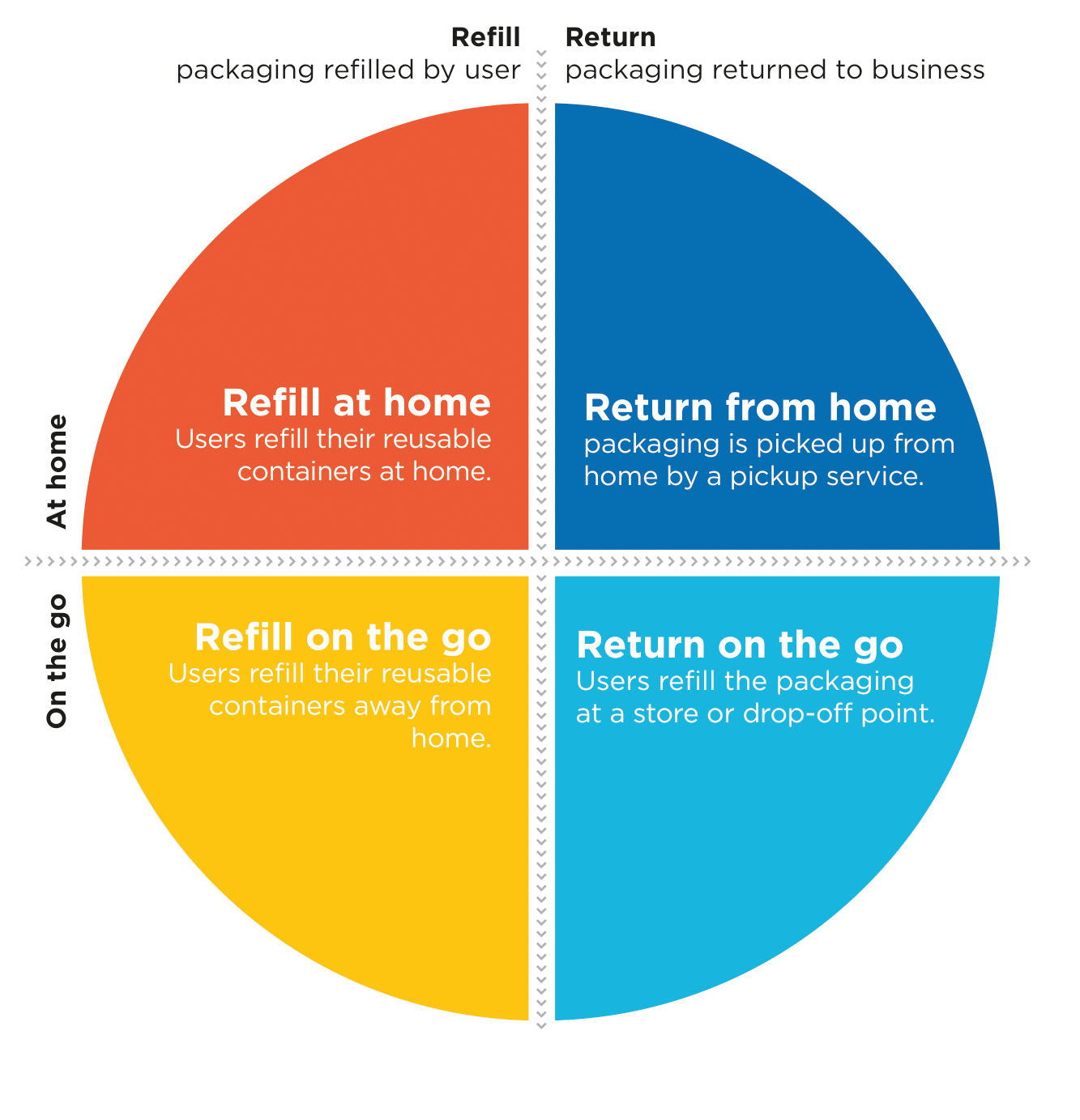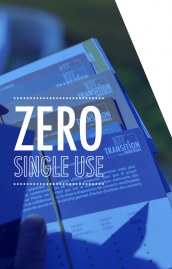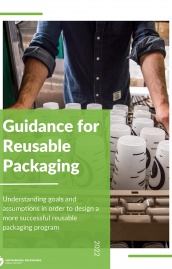Nothing new?
Let's reuse

Did you know that 10% of the wood cut down, 20% of the aluminium extracted, 40% of the plastic created and 50% of the glass produced are mainly used to make single-use packaging? In a world of finite resources, the disposable economy based on the principle of produce-consume-throw-away is increasingly showing its limits. What if another narrative was possible? Produce, use, reuse, reuse, reuse... The new zero waste laws in Luxembourg are approaching fast; zoom in on the path to reusing our packaging.
A ban on single-use packaging for on-site catering will be in place starting 2023, and the same rule will apply for take-away sales in 2025. A significant commitment for Luxembourg and its Null Offall strategy. The country will inevitably have to shift to reuse to achieve these ambitions. To its advantage, it can rely on numerous solutions and a network of actors, committed to boosting this fundamental circular economy principle. On the challenge side, there is a strong need for logistical organisation, standardisation and a renunciation of prevalent habits.
In 2020, the Pew Charitable Trust published a study suggesting the possibility of reducing ocean pollution by 80% by implementing a range of ambitious actions. At the top of the most impactful solutions: reducing production through redesigned products and packaging based on reuse...
Understanding the reuse of packaging...
Bottles, jars, parcels, transport bins, meal boxes, barrels... After almost completely disappearing in the 80s, reuse, and in particular the deposit system that our grandparents so dearly held onto, have made their return. Yet, what exactly are we talking about? Reusing packaging is when containers are used once more for the same purpose for which they were designed. After having been used, they are collected, washed and reintroduced into the circuit of use. For take-out or deliveries, this often works with a deposit system representing an additional sum paid by the consumer at the purchase and returned when the packaging is produced. It is also sometimes possible to bring your boxes, bags and other containers to promote reuse in hospitality sector as well as in stores.
Why is this trend coming back? Reuse overcomes the limits of recycling. As the IPCC reminds us in its April 2022 conclusions, recycling has been wrongly favoured over reuse in recent years. “The absence of policies aimed at better retention of material use, such as reduction, reuse, repair and remanufacturing, is due to institutional failures, lack of coordination and absence of strong advocates," says the report. The experts, therefore, recommend encouraging reuse to respond to significant environmental pressures, including the overexploitation of resources and various forms of pollution. Indeed, despite a significant progress in terms of awareness and action regarding single-use plastics, we have only replaced these plastics with other single-use products, substituting one set of environmental problems for another. In other words, while plastics are indeed disappearing from the environment, these alternatives sometimes mean more trees are cut down, as well as increased climate pollution and more toxic chemicals depending on the materials chosen.
Reuse, on the other hand, can have real benefits in a sustainable economy. On the carbon footprint side, for example, Zero Waste Europe and Reloop, in partnership with the University of Utrecht, published a report in December 2020 showing that packaging based on reuse (bottles, crates, jars and others) produced significantly fewer emissions than single-use containers. Another analysis of the Météor brewery in Alsace has shown that the reuse of their bottles allowed reductions of around 80% in greenhouse gas emissions compared to recycling, along with 75% of energy consumption and a third of the company's water consumption.
To ensure effective environmental results, however, reuse systems require the consideration of several aspects such as, for example, the material used for the container, the place of manufacture and preparation for reuse, the return rate and the number of uses, the potential for end-of-life recycling... There are many elements to consider in the great development potential of this type of offer in Luxembourg.
Beyond the green aspects, reuse also scores economic points. These solutions can indeed pride themselves on encouraging short-circuit consumption and creating local jobs for washing, maintenance or logistics activities that cannot be relocated. A study carried out for the European Commission establishes that support for deposits would thus be likely to create 27,000 jobs in Germany. On the contrary, the replacement of returnable packaging with single-use packaging would lead to the loss of 53,000 jobs there. Considering the supposed additional cost, it is also interesting to note that in Alsace, where reuse systems are more deployed compared to the Grand Duchy, water and other drinks are now sold at the same price, or even 20 % cheaper, than in single-use packaging. On a more macroeconomic scale, the Ellen MacArthur Foundation and the World Economic Forum estimate in a study entitled "The New Plastics Economy" that reuse models could offer an economically attractive alternative for at least 20% of single-use plastic packaging. Moreover, shortages linked to tensions over raw materials, particularly glass, related to the war in Ukraine, made the deposit solution particularly interesting from a cost and supplies securing perspective. Reuse thus stands out as a case for economic resilience.

The 4 reuse models
Challenges ahead
Let us look at this first quarter century. Companies operate by investing in packaging and one-way supply chains; cities and citizens organise themselves around recycling-based waste management, yet difficult to mainstream. It is hard to imagine going from an ultra-disposable economy to a reuse economy in the snap of a finger.
Upstream, a non-profit public interest organisation founded by a group of zero waste activists in the United States and Canada, examines this upscaling challenge in five pillars.
The first one is based on the need for more vision and alignment around the concept. In other words, although most actors aknowledge that reuse should be part of the future, there is still a need for consensus on implementing action plans.
Then comes the need for pilot projects and business models that are replicable on larger scales. Beyond reuse and refill schemes in catering, beverage production, home refill and tertiary packaging for warehouse transport, reuse remains a rare practice. It is less easily applicable at larger scale in many other sectors.
The third pillar refers to the lack of infrastructure directly related to upscaling. To develop reuse, interoperable collection, logistics and washing infrastructures that are capable of serving several companies simultaneously are essential. This will mean standardising reusable packaging in all formats to be interchangeable between reuse service providers and brands.
Fourth are convenience standards. Some companies fear that consumers and trading partners will not approve and participate in reuse schemes due to perceptions related to the comfort of using products packaged in disposable solutions.
Finally, costs are the last essential element. This is where policies aiming at restricting and penalising the use of disposable products and promoting reusable products will be crucial.
The reuse economy is built around a central question: “How to provide people with what they want and need without waste? ". To answer this question, many solutions already exist and are just waiting to be implemented. The challenge remains the upscaling, generalisation, and structuring of the different sectors. This transition will likely accelerate sharply because governments are establishing ambitious objectives in this area worldwide. In Chile, 30% of supermarket bottles must be returned. Austria has set its beverage packaging reuse quota at 25% by 2025, a rate set by Germany and the Netherlands at 70% by 2022. Meanwhile, Portugal, announced that, by 2030, 30 % of all packaging placed on the market needs to be reusable, all materials combined. The Reuse Economy has a bright future ahead of it.
To be read also in the dossier "The second life of our packaging"






